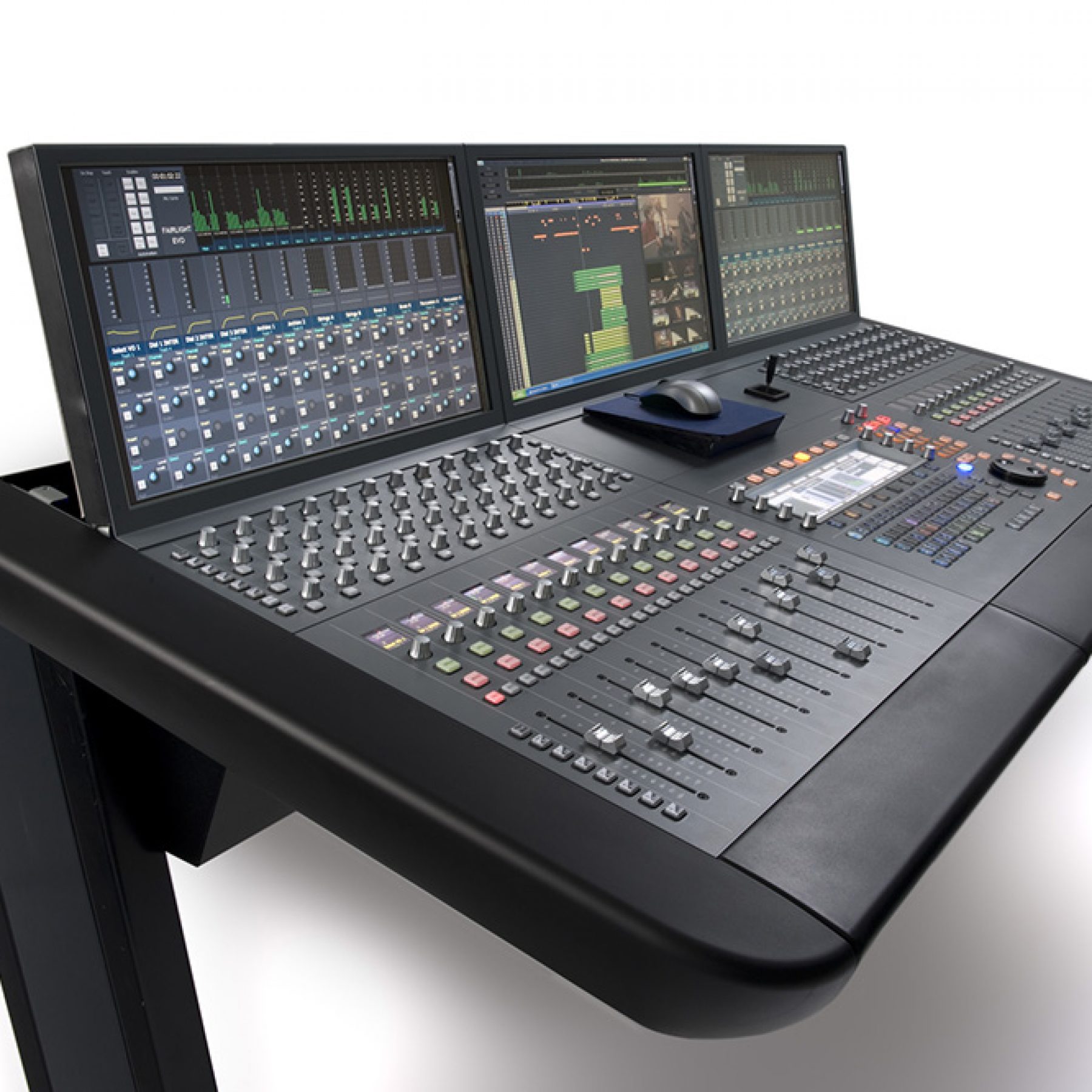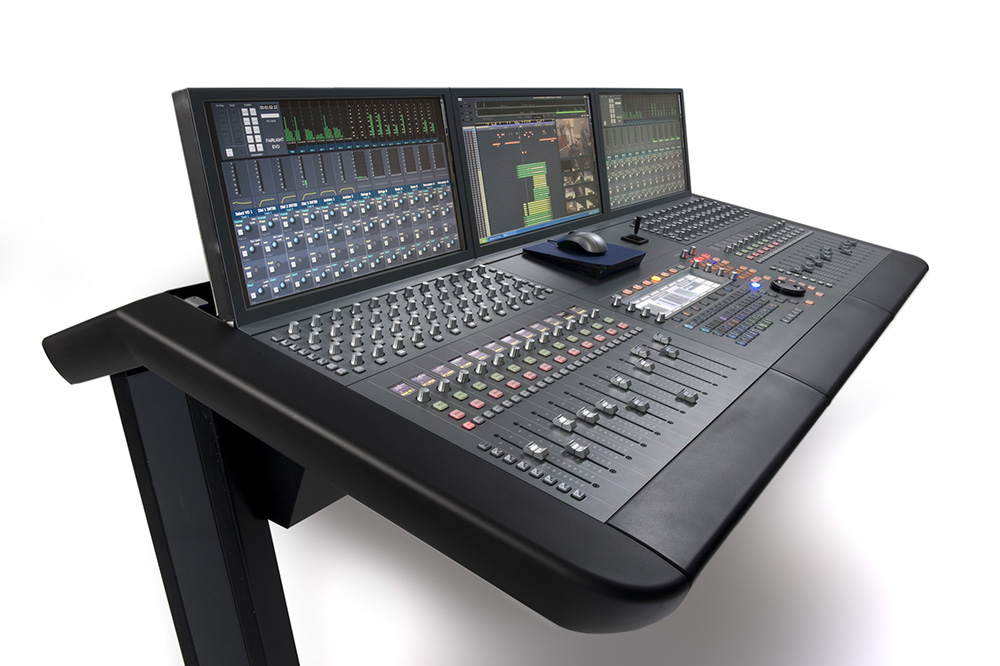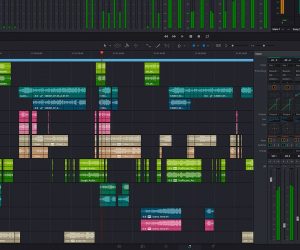
FAIRLIGHT EVO

It’s another step forward in the world of large-format digital consoles, only this time the price steps back.
Text: Michael Gissing
Being the happy Fairlight Xynergi user that I am, I’ve been more than curious to set eyes and ears on Fairlight’s new EVO console, so when the opportunity finally arose to check one out at Fairlight HQ during a recent trip to Sydney, I jumped at it. With EVOs marching out the door as fast as they can be built and tested, it’s been difficult to organise some quality face-time with the console, so intense has the pressure been to get them out the door and into the hands of eager customers.
As many AT readers may already be aware, the recent success of the current range of Fairlight products has fundamentally been about the development of its revolutionary Crystal Core, which packs tons of power onto a single FPGA card and draws only a tiny amount of power to deliver hundreds of tracks of audio and bus processing. Having already stolen a considerable march on most of its competitors with the Crystal Core technology, the Fairlight team has recently concentrated its efforts on finessing the control surfaces and software that drive it. The latest of these is the EVO.
HIGHLY EVOLVED
Part new hardware configuration and part software development, the EVO is a bridge between the Fairlight Constellation console and the desktop Xynergi. Constructed using the same physical framework as the Constellation, and incorporating a Xynergi controller into the centre section, the EVO allows for up to five console bays, made up of four 12-channel fader packs and a central control panel. Along with the Xynergi, which features self-labelling keys, transport controls, jog/data input wheel and numeric keypad, this centre section allows space for three small additional panels – but more on that in a moment.
A most obvious new feature of the EVO console is the in-line panel (ILP) that sits directly above the fader panel, adding four touch-sensitive continuous rotary pots and four buttons per channel. This fundamental addition to the console is the result of extensive user feedback – the consensus view apparently being that the modern virtual console “needs a few more buttons and knobs,” hence the inclusion of the ILP, along with a matching display on a 20-inch computer screen that sits above each panel. There are no legends written on the ILPs themselves, which at first looks a bit odd, but the reason for this is simple. Each controller’s functionality can vary greatly depending on whether you’re looking at EQ, dynamics, auxes, or plug-ins etc, or indeed dedicating the whole panel to a single channel. Ergonomically, the combined depth of the fader and in-line panels are still within easy reach of ‘vertically challenged’ operators such as myself, and the overall layout creates a nice channel strip effect familiar to both old-school and next-gen mixers.
The ILP also offers a way to swipe values from one channel to multiple channels. While holding a value on the pot of one channel, transferring this value across to others simply involves swiping the finger over the adjacent channels with a horizontal movement across the tops of the pots. This is not as elegant as the way in which a Smart console swipes values perhaps, but it’s certainly an improvement on the way Fairlight channel values were previously copied and pasted to other channels.
GREY & MISERLY
The EVO also moves on from the Constellation aesthetic by going for a grey, low-reflective colour scheme. Again, user feedback has been dutifully considered here. Gone are the shiny silver panels that reflect distractingly under studio lighting, replaced by darker and less reflective surfaces. This is particularly noticeable in the changes to the skin of the edit and mix panel screens, which also share this matching dark grey aesthetic. As an added bonus, this change plays a significant role in further enhancing Fairlight’s already ‘green’ reputation (established by the Crystal Core card which is a dead-set miser when it comes to power consumption). The darker screens use far less power than they did when the GUIs were predominantly white. I remember reading
with astonishment the global power savings that could be achieved if the Google search engine’s default screen was simply black, not white. But frugal power consumption isn’t the only reason why Fairlight’s new-look interface appeals to me. It also evokes memories of the old dSP screen livery… though this is more than mere nostalgia: the darker screen is much less fatiguing on the eyes.
The fader panels have also undergone several significant developments. Firstly, the OLED displays in the new panels are higher in resolution, offer faster refresh speeds and now sport full colour. These new displays include metering, automation status, fader value and panning. The new OLEDs are brilliant and can be read from any angle. Being colourised, they offer particularly good visual feedback of many user functions, particularly automation. Secondly, the buttons that flip fader sets and control various other functions are now down the left-hand side of the panel, while the surround pan joystick has been removed from it entirely. This joystick now sits more comfortably above the Xynergi controller. All this trimming has enabled the panel to be reduced in depth and allow the new ILP to sit within comfortable reach in the frame above. Fairlight is also currently working on a dedicated monitoring panel that will sit above the Xynergi controller. The idea will be that the user can arrange these panels wherever he or she pleases within the three-panel space.
WHAT’S IN A NAME?
Metering and track naming is now everywhere on the Fairlight: in the edit page, on the fader panel, on the ILP display and also on the Fairlight Mix Control (FMC2) page. The FMC2 page is essentially a graphic overview of the mixer and here Fairlight has changed from its older, ‘quirkier’ display, to a more familiar mixer layout that shows a classic channel strip configuration with yet more metering. On top of the extensive bus and main metering, the company has added three new metering displays that have again found their way into the design courtesy of user feedback. First up is the PPM display, which accurately shows the classic BBC analogue PPM metering. Personally, I find this more of a curiosity than anything else, but others will no doubt be far more thankful for its inclusion. The next two meters, although somewhat controversial, are fast becoming an important requirement in broadcast environments – LEQ and LU meters. This metering represents an attempt to quantify ‘apparent loudness’, weighted to program dialogue levels and based on an internationally published spec. Since the most common audio complaint by TV listeners is variable loudness, and given the propensity of broadcasters to streamline presentations, studios are being lumbered with the task of homogenising program loudness. This is both a good and bad thing but I won’t venture into a rant about my views on apparent loudness here.
The intent of LEQ metering is to display a dBFS value of the average dialogue loudness over a 10-second cycle and the LU meter does the same over the total duration of the program. Deliveries to broadcasters like Discovery now insist on LEQ and LU metering so I’m grateful to Fairlight for including this measuring and metering set, saving me and many others the unnecessary expense of buying an external box to measure these values.
V3 SOFTWARE AUTOMATION
One of the huge advantages of the combined panel and screen displays is the flexibility to make ongoing improvements and to implement new features. There’s considerable development in the version 3 software that comes with the EVO, which is soon to be available to Xynergi and Constellation users as all systems are based around the Dream2 software. Full backwards compatibility is also maintained; something that other disk-based editing companies should look at more seriously.
There’s a host of new improvements and features in version 3 of the software, but the most exciting of them (to me at least) relates to the automation. Automation can now be quickly written via touch-sensitive faders and pots in any jog-forward speed, and will write until the transport moves backwards. You can hear audio when jogging of course, so allowing this capacity provides the power to accurately make slow motion fader adjustments while hearing the effect, thus mostly negating the need to mouse-draw fader values. It’s more intuitive to grab the fader than a mouse and draw with the combined left hand on fader and right hand manipulating the jog wheel. Unlike a mouse, multiple fader or pot changes can also be made in this jog/write mode. Another nice idea is that automation values can be written by simply touching a fader or pot and jumping or locating to any forward position, and then simply moving the transport backwards. By performing this sneaky manoeuvre, values will be written from the touch point up to the backwards move. Of course, a whole set of values can be set while stationary and then it’s just simply a matter of jumping – say to the end of a set of clips – to write them over that range. This is also a great way to trim a lot of relative values within a scene.
The other big improvement is that automation is now an undo function like any edit. This means that multiple automation passes can be undone unlike the previous limit of one pass. To see what you’re doing, it’s also possible to open up the undo dialog box to show the list of all previous events that can be undone including clip edits. There have also been improvements in the way clips and automation can be cut, copied and pasted together, which basically brings Fairlight up to speed with other systems. The total automation package
is significantly improved and hopefully paves the way for clips plus full automation to be edited between projects – a feature we all desperately need in this age of re-versioning and changing of edits during mixing and tracking.
There are dozens of other new features, including improved plug-in handling, video file codec compatibility and AAF export/import. There’s also a fabulous new feature that allows you to find and add the missing tracks of a multi-track broadcast wav file. This is a common problem when a video editor has deleted a few tracks by unlinking a multi-channel broadcast wav file in an edit sequence. Fairlight now makes it possible to locate and restore all the missing tracks to the timeline.
D-EVO
Although Fairlight has been making big improvements in the functionality of the Dream2 family – and particularly with
the EVO console – the Australian company hasn’t altogether forgotten its roots. For all the music people out there who might imagine using this fantastic sounding, powerful editing and mixing system for music, Fairlight has a final big announcement with its pending version 3.1 software release: as well as hundreds of tracks, a powerfully configurable mixer and embedded editable video, Fairlight has finally added MIDI tracks! The implications of this announcement goes way beyond music production and all the way to event control, including large-scale undertakings such as the Olympic Games. As they say, the plot thickens.
Overall, the EVO build is solid and looks great. By using the same frame as the Constellation, the upgrade path for Constellation users is cheaper and simplified, while the In
Line Panel is a smart extension that helps to create a more traditional channel strip configuration. The hardware improvements like the colour OLEDs are excellent and the software developments are further icing on the cake. As the name suggests the EVO is evolutionary rather than revolutionary, and goes a long way towards further cementing Fairlight’s position as a high-end yet affordable film, broadcast post and – once again – music system.
















Hello.
I am selling my EVO 5 Bay, mi CC2, MADI cards, PC, SX20, last software from Fairlight because I am retiring. If you are interested, gladly also as spare parts storage. Contact me if you are interested.
Greetings from Mainz
Alfred Huff